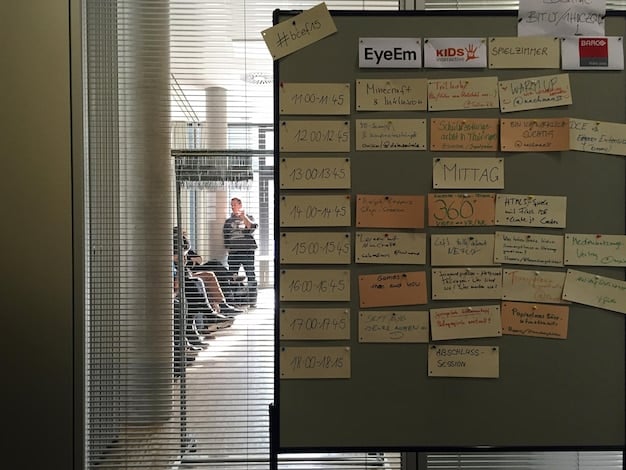Agile Task Management: A 2025 Guide for US Teams

The Updated Guide to Agile Task Management for US Teams in 2025 explores how agile methodologies enhance teamwork, boost productivity, and adapt to rapidly changing project landscapes, providing actionable strategies for successful implementation.
Are you ready to transform your team’s approach to project management in 2025? This updated guide on agile task management provides US teams with the essential strategies and tools to thrive in a rapidly evolving business environment. Let’s dive in and discover how agile can revolutionize your workflow!
Understanding Agile Task Management in 2025
Agile task management is no longer just a buzzword; it’s a crucial framework for US teams aiming for efficiency and adaptability. In 2025, understanding its core principles is essential for navigating the complexities of modern project management.
This approach emphasizes iterative development, teamwork, and customer satisfaction. Let’s explore what makes agile task management a game-changer for your team.
Key Principles of Agile Management
Agile methodologies are built on several key principles that drive successful project execution. Here’s what you need to know:
- Customer Collaboration: Involving customers throughout the project ensures their needs are met.
- Embracing Change: Adapting to changes quickly is crucial in agile environments.
- Iterative Development: Delivering working software in short iterations allows for continuous improvement.
Benefits of Agile Task Management
Implementing agile task management offers numerous advantages. Here are some key benefits:
- Improved Team Collaboration: Agile promotes better communication and teamwork.
- Increased Flexibility: Agile teams can quickly adapt to changing requirements.
- Higher Quality Products: Continuous testing and feedback result in better products.

In conclusion, understanding and embracing agile task management is pivotal for US teams looking to stay competitive and innovative in 2025. By focusing on collaboration, adaptability, and continuous improvement, teams can achieve greater success.
Setting Up Your Agile Task Management System
Setting up an agile task management system requires careful planning and the right tools. The goal is to create a streamlined process that enhances productivity and collaboration within your US team.
Here’s a step-by-step guide to help you establish an effective agile system.
Choosing the Right Tools
Selecting the appropriate tools is critical for successful agile task management. Consider these options:
- Task Management Software: Tools like Jira, Trello, and Asana are popular choices.
- Communication Platforms: Slack and Microsoft Teams facilitate real-time communication.
- Collaboration Tools: Google Workspace and Confluence enhance document sharing and teamwork.
Creating a Workflow
Developing a clear workflow is essential for managing tasks efficiently. Follow these steps:
- Define Task Categories: Break down tasks into manageable categories.
- Prioritize Tasks: Use methods like MoSCoW (Must have, Should have, Could have, Won’t have) to prioritize.
- Assign Tasks: Clearly assign tasks to team members based on their skills and availability.
In conclusion, setting up an agile task management system involves choosing the right tools and creating a clear workflow. By carefully planning and implementing these steps, US teams can significantly improve their project outcomes.
Implementing Scrum for Agile Task Management
Scrum is a popular framework for implementing agile task management. It provides a structured approach to project development with specific roles, events, and artifacts. For US teams, understanding Scrum is crucial for optimizing their agile practices.
Let’s explore how Scrum can be effectively implemented in your team.
Key Scrum Roles
Understanding the roles within a Scrum team is essential for effective collaboration. The key roles include:
- Product Owner: Responsible for defining the product backlog and prioritizing features.
- Scrum Master: Facilitates the Scrum process and removes impediments.
- Development Team: Responsible for delivering the product increment.
Scrum Events
Scrum events provide a structured framework for planning, executing, and reviewing work. The main events are:
- Sprint Planning: The team plans the work to be completed in the upcoming sprint.
- Daily Scrum: A short daily meeting where the team synchronizes activities and plans for the day.
- Sprint Review: The team demonstrates the completed work to stakeholders.
- Sprint Retrospective: The team reflects on the sprint and identifies areas for improvement.
In conclusion, implementing Scrum can significantly enhance agile task management for US teams. By understanding the roles and events, teams can improve their productivity and deliver higher-quality products.
Leveraging Kanban for Agile Task Management
Kanban is another popular framework for agile task management, offering a visual approach to managing workflow. For US teams seeking a flexible and adaptable method, Kanban can be a great choice.
Let’s explore how Kanban can be effectively leveraged to improve your team’s task management.
Understanding Kanban Boards
Kanban boards are visual tools that help teams manage their workflow. They typically consist of columns representing different stages of the task process, such as:
- To Do: Tasks that need to be completed.
- In Progress: Tasks currently being worked on.
- Completed: Tasks that have been finished.
Key Kanban Principles
Kanban is based on several core principles that guide its implementation:
- Visualize the Workflow: Using a Kanban board to make the workflow visible.
- Limit Work in Progress (WIP): Reducing the number of tasks being worked on to improve focus.
- Manage Flow: Optimizing the flow of tasks through the system.

In conclusion, leveraging Kanban can significantly improve agile task management for US teams. By visualizing the workflow, limiting work in progress, and managing flow, teams can enhance their efficiency and deliver better results.
Integrating Agile with Other Methodologies
While agile methodologies are powerful on their own, integrating them with other project management approaches can provide even greater benefits. For US teams, understanding how to combine agile with methodologies like Waterfall or Lean can lead to more effective project outcomes.
Let’s explore how to integrate agile with other approaches to maximize your team’s potential.
Agile and Waterfall
Combining agile and Waterfall methodologies can be a strategic approach for certain projects. Here’s how:
- Hybrid Approach: Use Waterfall for initial planning and agile for development.
- Phased Implementation: Implement agile gradually in Waterfall environments.
- Project Selection: Choose projects that are suitable for a hybrid approach.
Agile and Lean
Integrating agile with Lean principles can optimize efficiency and reduce waste. Consider these strategies:
- Value Stream Mapping: Identify and eliminate waste in the value stream.
- Continuous Improvement: Implement a culture of continuous improvement using Lean principles.
- Focus on Customer Value: Prioritize tasks that deliver the most value to the customer.
In conclusion, integrating agile with other methodologies allows US teams to leverage the strengths of different approaches. By combining agile with Waterfall or Lean, teams can achieve greater efficiency and deliver higher-quality results.
Best Practices for Agile Task Management in 2025
To maximize the benefits of agile task management in 2025, US teams should adopt best practices that enhance collaboration, adaptability, and efficiency. Staying current with these practices will ensure your team stays competitive and delivers exceptional results.
Let’s explore the best practices that will drive your team’s success.
Enhancing Team Collaboration
Effective team collaboration is the cornerstone of successful agile task management. Focus on these strategies:
- Regular Communication: Conduct daily stand-up meetings to keep everyone informed.
- Shared Understanding: Ensure all team members understand the project goals and requirements.
- Feedback Loops: Encourage continuous feedback to improve processes and outcomes.
Adapting to Change
Agile teams must be prepared to adapt to changing requirements and priorities. Implement these practices:
- Flexible Planning: Use rolling wave planning to accommodate changes.
- Prioritization Techniques: Employ methods like MoSCoW to adjust priorities quickly.
- Continuous Learning: Stay updated with the latest agile trends and technologies.
In conclusion, adopting best practices for agile task management will enable US teams to thrive in 2025. By focusing on collaboration, adaptability, and continuous improvement, teams can achieve greater success and deliver exceptional results.
| Key Point | Brief Description |
|---|---|
| 🚀 Agile Principles | Focus on customer collaboration, embracing change, and iterative development. |
| 🛠️ Tool Selection | Choose appropriate software for task management, communication, and collaboration. |
| 🔄 Scrum Implementation | Assign roles such as Product Owner, Scrum Master, and Development Team. |
| 📊 Kanban Boards | Visualize workflow with columns like “To Do,” “In Progress,” and “Completed.” |
Frequently Asked Questions
▼
Agile task management is an iterative approach to project management that focuses on collaboration, flexibility, and continuous improvement. It allows teams to adapt to changes quickly and deliver value incrementally.
▼
Scrum provides a structured framework for agile task management with specific roles, events, and artifacts. It helps teams organize their work, prioritize tasks, and deliver working software in short iterations.
▼
Kanban boards offer a visual representation of the workflow, making it easier to identify bottlenecks and manage tasks. They enhance transparency, reduce work in progress, and improve flow efficiency.
▼
Agile and Waterfall can be integrated using a hybrid approach where Waterfall is used for initial planning and agile for development. This allows teams to combine the strengths of both methodologies.
▼
Best practices include enhancing team collaboration through regular communication, adapting to change with flexible planning, and prioritizing tasks to deliver maximum customer value. Continuous learning is also key.
Conclusion
In conclusion, embracing agile task management is essential for US teams looking to succeed in 2025. By understanding the core principles, implementing the right tools and frameworks, and adopting best practices, your team can achieve greater efficiency, adaptability, and collaboration.





